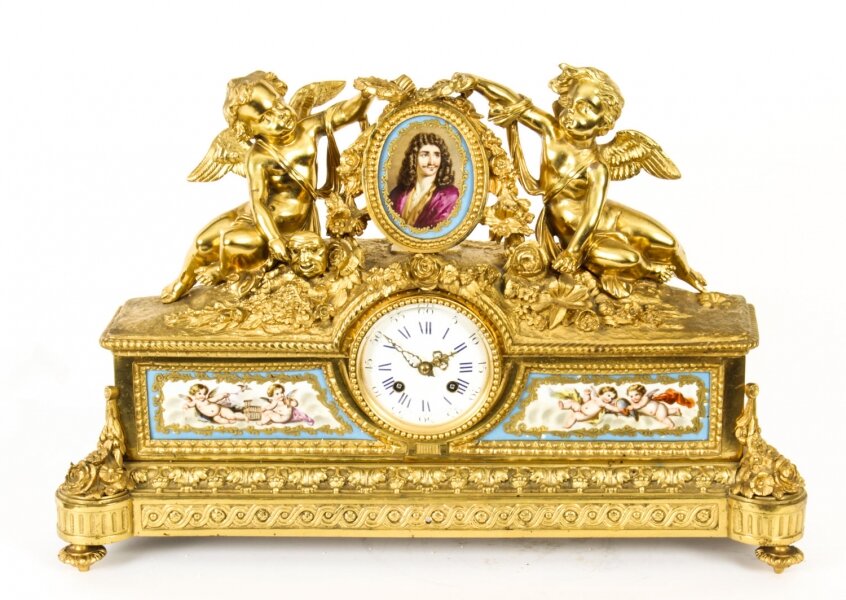French gilt bronze mantel clock with Bleu Celeste porcelain panels
An exquisite example of French craftsmanship, the antique French gilt bronze mantel clock with Bleu Celeste porcelain panels in the Sevres manner, circa 1860, is a striking representation of the opulence and artistry that defined 19th-century France. This clock, blending luxurious materials, intricate design, and timeless beauty, stands as a testament to the rich cultural and artistic heritage of the period.
 This fascinating clock is available for sale at Regents Antique
This fascinating clock is available for sale at Regents Antique
Please Note: The image will not be shown if the painting is sold or removed from the Regent Antique
Gilt Bronze Case
At the heart of this mantel clock is its beautifully crafted gilt bronze case, a hallmark of French clockmaking in the mid-19th century. The gilt bronze, which has been lavishly coated in gold, not only imparts a sense of grandeur but also reflects the tastes of the time, when the wealthy sought to adorn their homes with objects that exuded luxury. The bronze has been masterfully cast into an ornate form, with delicate scrolls, floral motifs, and intricate detailing throughout. The high-quality gilt finish shines with a radiant luster, accentuating the elegance of the piece and giving it a captivating, luminous quality.
The clock’s case is often adorned with finely sculpted decorative elements. This could include scrolling acanthus leaves, rosettes, and motifs that reflect the Romantic and Neo-Classical design influences prevalent in mid-19th-century French decorative arts. These details were meticulously applied by skilled artisans, creating an object that is both functional and artistic.
Bleu Celeste Porcelain Panels
One of the most striking features of this clock is the inclusion of Bleu Celeste porcelain panels. This distinctive color, a pale, soft blue, was highly sought after during the 19th century, particularly in porcelain objects that aimed to emulate the renowned Sevres porcelain factory. Sevres, located near Paris, was the epitome of French porcelain production, and its wares were coveted by collectors and aristocrats throughout Europe.
The Bleu Celeste panels on this clock evoke the elegance and refinement of Sevres porcelain, even if they were not produced by the factory itself. The porcelain is typically hand-painted with intricate scenes or designs, often inspired by classical themes, nature, or allegorical representations. These panels might feature romanticized depictions of landscapes, mythological figures, or cherubic scenes, and are usually framed in a gilded bronze border to contrast with the delicacy of the porcelain and enhance the visual appeal of the clock.
The Dial and Movement
The clock dial, which sits within the gilt bronze frame, is a further example of fine craftsmanship. Often made of porcelain or enamel, the dial is marked with Roman numerals and delicate gilt hands. The enamel surface is often white, providing a stark contrast to the golden case and allowing the time markers to stand out. The simplicity and elegance of the dial design speak to the prevailing aesthetic of the period, where function and form were balanced seamlessly.
The clock movement itself would be a mechanical marvel of the time. French mantel clocks from the mid-19th century were known for their precision and reliability. The clock would typically feature a time-and-strike movement, allowing it to chime on the hour or half-hour, adding an auditory element to the visual beauty of the piece. The movement would have been crafted by one of the renowned clockmakers of the era, whose skill ensured that the clock was not only a stunning decorative object but also a reliable timekeeper.
Historical Context and Artistic Significance
The mid-19th century was a time of great upheaval in France, with the fall of the Bourbon monarchy, the rise and fall of Napoleon, and the subsequent establishment of the July Monarchy under King Louis-Philippe. During this period, French decorative arts flourished, particularly in the production of luxury items like clocks, furniture, and porcelain. The combination of gilt bronze and porcelain in the style of Sevres was particularly popular in this period, as it represented the epitome of both French elegance and technical achievement.
This period saw a revival of classical forms, which were blended with the romanticism and exuberance of the era. The clock, with its opulent use of gilded bronze and delicate porcelain, embodies this stylistic tension, balancing the solidity of bronze with the fragility of porcelain and the timeless elegance of classical design.
This clock also reflects the growing demand for decorative pieces in bourgeois homes, as the newly affluent middle class sought to emulate the aristocracy’s opulent lifestyles. Items like this clock, with its association with royal and aristocratic tastes, were often displayed in drawing rooms or parlors, symbolizing the owner’s wealth, taste, and cultural sophistication.



